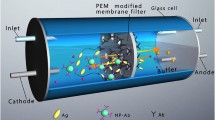Abstract
Poly-N-isopropylacrylamide (polyNIPAAm), a water-soluble, thermally precipitating synthetic polymer, has been conjugated together with a monoclonal antibody (MAb) and utilized in a novel separation method for an immunoassay. The PolyMPAAm precipitates out of water above a critical temperature of 31°C, enabling a polymerbound immune complex to be separated from the solution. The principal advantages of this method are that it utilizes a homogeneous incubation for the antigen-antibody reaction, plus, it has the ability to assay large-molecular-weight antigens with sensitivities equivalent to other nonisotopic heterogeneous immunoassays. In addition, since the polymer-immune complex may be reversibly redissolved by cooling, the method may be used both to concentrate the signal and isolate the analyte. This general technique may also be used for a wide variety of separation processes in addition to immunoassays, in which a specific component in a biological fluid, industrial process stream, or body of water is to be isolated for analysis, recovery, or disposal. Thus, product recovery and/or toxin or pollutant removal processes are possible with this methodology.
Similar content being viewed by others
References
Ngo, T. T. and, Lenhoff, H. M., eds. (1985),Enzyme Mediated Immunoassay, Plenum, New York.
Maggio, E. T., ed. (1980),Enzyme Immunoassay, CRC, Boca Raton, FL.
Langune, J. J., and Vunakis, H. Van, eds., Immunochemical Techniques inMethods in Enzymology, Parts B and C, vol. 74, 1981, Part D, vol. 84, 1982, and Part E, vol. 92, 1983, Academic New York, NY.
K. Miyai (1985),Adv. Clin. Chem. 24, 61.
Monji, N., and Hoffman, A. S., Patent Pending.
Molyneux, P. (1985),Water-Soluble Synthetic Polymers: Properties and Behavior, vol. 1, CRC, Boca Raton, FL.
Heskins, M., and Guillet, J. E. (1968),J. Macromol. Sci. Chem. A2,8, 1441.
Pollack, H., Blumenfeld, M., Wax, R. L., Baughn, and Whitesides G. M., (1980),J. Am. Chem. Soc. 102, 6324
Cole, C. A., Schreiner, S. M., Priest, J. H., Monji, N., and A. S. Hoffman, (198),N-Isopropyl Acrylamide and N-Acryl Succinimide Copolymers: A Thermally Reversible Water Soluble Activated Polymer for Protein Conjugation, inACS Symposium Series, Reversible Polymeric Gels, P. Russo, ed., ACS, Washington, DC in press.
Jones, T., and Houghton, R. L., (1986),Clin. Chem. 32, 1067.
Author information
Authors and Affiliations
Rights and permissions
About this article
Cite this article
Monji, N., Hoffman, A.S. A novel immunoassay system and bioseparation process based on thermal phase separating polymers. Appl Biochem Biotechnol 14, 107–120 (1987). https://doi.org/10.1007/BF02798429
Received:
Accepted:
Issue Date:
DOI: https://doi.org/10.1007/BF02798429




